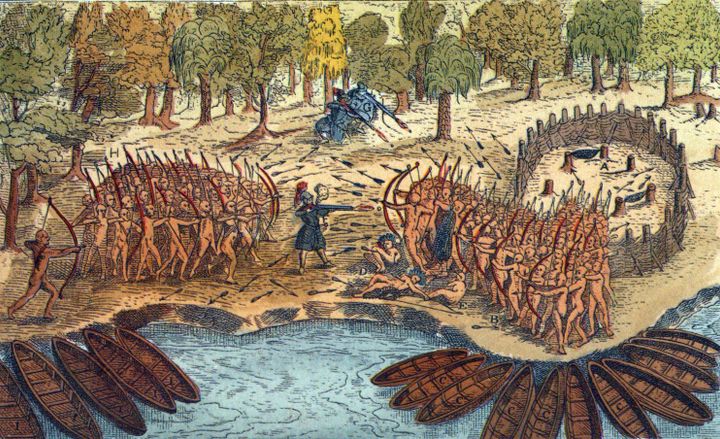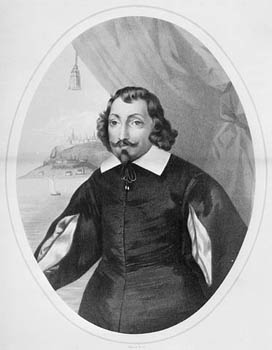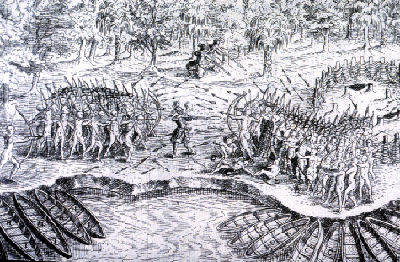Samuel de Champlain
This timeline chronicles major events in Samuel de Champlain's life.

-
March 15, 1603

Undefined
Champlain's First Trip
Samuel de Champlain boarded the Bonne-Renommée at Honfleur, France, destined for New France, as a private passenger on Gravé Du Pont's expedition.
-
May 26, 1603

Undefined
Champlain Reaches Tadoussac
Samuel de Champlain reached Tadoussac on the north shore of the St Lawrence River and set foot for the first time in New France.
-
June 11, 1603

Undefined
Champlain Learns of Hudson Bay
Samuel de Champlain travelled nearly 60 km up the Saguenay River, and learned from the Montagnais tribe that a large saltwater body existed to the north (the Hudson Bay).
-
July 04, 1603
Undefined
Champlain Reaches Montréal
Samuel de Champlain explored the Saguenay River and journeyed up the St Lawrence River, reaching the Lachine Rapids and the future site of Montréal on July 4.
-
July 15, 1603

Undefined
Champlain Arrives at Gaspé
Samuel de Champlain arrived at Gaspé, where he first heard about Acadia.
-
September 02, 1604

Undefined
Champlain Explores Bay of Fundy
Samuel de Champlain began exploring the Bay of Fundy to seek an ideal site for a permanent settlement, becoming the first European to create a geographical description of the area.
-
September 05, 1606
Undefined
Expedition to Massachusetts
Samuel de Champlain and Jean de Poutrincourt launched another expedition from Port-Royal to explore the coast of Massachusetts, hoping to establish friendly relationships with the Secoudon and Messamouet in the area. Their efforts were met with hostility and soon abandoned.
-
August 11, 1607
Undefined
Port-Royal Abandoned
The Port-Royal settlement was abandoned on orders from France. On Sept 3, after skirting the Straits of Canso and mapping the Atlantic coastline from Cape Breton to the south of Cap Blanc, Samuel de Champlain and the other voyagers headed home to St Malo. Only Poutrincourt would return, in 1610.
-
April 13, 1608

Undefined
Champlain Leaves on 3rd Voyage
As lieutenant to the Sieur de Monts, Samuel de Champlain set out on his third voyage to New France. He arrived at Tadoussac on 3 June.
-
July 03, 1608

Undefined
Founding of Québec
Samuel de Champlain established a fortified trading post at Québec, the perfect location to foster the fur trade and to serve as the base for its founder's idea of colonizing the remote country.
-
June 28, 1609

Undefined
Champlain Explores Haudenosaunee Country
Samuel de Champlain explored Haudenosaunee country, entering the Rivière des Iroquois (Richelieu), paddling upriver and reaching a great lake that would later bear his name.
-
July 30, 1609

Undefined
Champlain Battles the Haudenosaunee
Champlain and his First Nations allies battled the Haudenosaunee on Lake Champlain, beginning 150 years of war between Iroquois and French. Champlain's musket kills three and astonishes the enemy.
-
October 13, 1609

Undefined
Champlain Returns to France
Samuel de Champlain arrived back in France, ready to report to the king on the success of New France and extol the virtues of the Québec habitation as a warehouse for the fur trade.
-
August 08, 1610

Undefined
Champlain Sets Sail for France
After a disastrous year for the fur trade, Samuel de Champlain set sail for France, leaving behind 16 men under the command of Jean de Godet Du Parc.
-
December 27, 1610

Undefined
Champlain Marries
At the approximate age of 40, Samuel de Champlain entered into an elaborate marriage contract with Hélène Bouellé, aged 12, who brought a large dowry. They were married in Paris on December 30; the marriage came into effect two years later.
-
May 28, 1611

Undefined
Champlain Leaves for Lachine
Samuel de Champlain left Québec and arrived at Lachine and named the island in the middle of the St Lawrence River St. Hélène for his wife.
-
June 13, 1611

Undefined
Champlain Shoots Rapids
Samuel de Champlain impressed his native allies by shooting the dangerous Lachine Rapids in a canoe.
-
October 08, 1612
Undefined
Bourbon Named Lieutenant-General of New France
Louis XIII named Charles de Bourbon, Comte de Soissons, as his lieutenant-general in New France. Bourbon chose Samuel de Champlain as his lieutenant on Oct 15.
-
January 09, 1613

Undefined
Champlain Publishes Voyages
Samuel de Champlain published his Les Voyages du Sieur de Champlain, describing his adventures in New France.
-
May 29, 1613

Undefined
Champlain Reaches Ottawa River
Champlain reached the mouth of the Ottawa River. On June 4 he noted the mouths of the Gatineau and Rideau rivers at the present site of Ottawa.
-
September 26, 1613

Undefined
Champlain Promotes New France
Champlain left for France, where he remained until April 24, 1615 to promote the cause of New France.
-
May 25, 1615
Undefined
Récollets Arrive
Four Récollets from France arrived at Tadoussac with Champlain, only to quickly go their separate ways. The best-known Récollet, Gabriel Sagard, later published Le Grand Voyage du pays des Hurons, an indispensable source of knowledge of Huron customs and culture.
-
July 01, 1615

Undefined
Champlain Visits Huronia
French explorer Samuel de Champlain reached Huronia, at the southern end of Georgian Bay.
-
July 09, 1615

Undefined
Champlain Treks Up Ottawa River
Samuel de Champlain began his journey up the Ottawa River, passing through the Lac des Népissingues (Lake Nipissing), the Rivière des Français (French River) and the great Lac Attigouautau (Lake Huron). He arrived among the Hurons on 1 August.
-
August 01, 1615

Undefined
Champlain Arrives at Huronia
Samuel de Champlain completed his journey up the Ottawa River, arriving among the Hurons.
-
September 01, 1615
Undefined
French Mobilize Forces
An attack force of 500 First Nations and French moved out from Cahiagué, Huronia, to present-day Orillia. On Sept 8 Champlain sent Etienne Brulé to make contact with the SusQuéhanna.
-
October 11, 1615

Undefined
Champlain Wounded
Samuel de Champlain was wounded twice in the leg by arrows when he and his Huron-Wendat allies stumbled upon an Haudenosaunee fort.
-
October 11, 1615

Undefined
Champlain's Third Battle with the Haudenosaunee
Champlain and his allies arrived at a Haudenosaunee fort on Lake Onanadaga, just north of present-day Syracuse. The Haudenosaunee routed the invaders, wounding Champlain with two arrows.
-
January 15, 1616

Undefined
Champlain Leaves Huronia
Samuel de Champlain left Huronia to visit the Tobacco Nation (south of Nottawasaga Bay), then the Cheveux-Relevés (Ottawas, south of Georgian Bay), extending an invitation to the natives to come to Québec.
-
September 10, 1616

Undefined
Champlain Returns with Map
Samuel de Champlain arrived in France, where he would publish an engraved map of New France.
-
March 12, 1618
Undefined
Louis XIII Initiates Colony
King Louis XIII instructed Samuel de Champlain and his partners to establish a viable colony in New France.
-
May 18, 1619
Undefined
Voyages Published
The Voyages and Explorations of Samuel de Champlain, an account of Samuel de Champlain's adventures in New France, was published.
-
May 07, 1620

Undefined
Champlain Becomes Governor
Louis XIII wrote to Samuel de Champlain, commissioning him to govern New France and to do so in accordance with the laws and customs of France. From that point, Champlain devoted himself almost exclusively to administration and his career as an explorer ended.
-
August 21, 1624

Undefined
Champlain Leaves Québec
With construction of a new habitation well underway, Champlain left Québec with his wife, who would not to return. He landed at Dieppe, France in October.
-
April 27, 1628
Undefined
Oxen in New France
Samuel de Champlain recorded in his journal that, for the first time in New France, land had been broken by the plough drawn by oxen, a task typically carried out by human strength.
-
July 20, 1629

Undefined
Champlain Surrenders Québec
Champlain wrote the articles of capitulation on July 19 and on the following day surrendered Québec to the English adventurer David Kirke and his brothers. He was captured and taken to England.
-
March 29, 1632

Undefined
Treaty of Saint-Germain-en-Laye
France recovered Québec from England in the Treaty of Saint-Germain, along with compensation for goods siezed when Champlain surrendered Québec.
-
March 01, 1633

Undefined
Champlain Recommended to Lead Colony
Asked by Cardinal Richelieu to take command of the colony, Isaac de Razilly deferred to Champlain as being more competent in colonial affairs.
-
March 23, 1633

Undefined
Champlain's Final Voyage
Samuel de Champlain set sail on his final voyage to Québec at age 63.
-
May 23, 1633

Undefined
Champlain Returns to Québec
Champlain returned to Québec and began to rebuild the Habitation from its ruins and to build the church of Notre-Dame-de-la-Recouvrance.
-
August 18, 1634

Undefined
Champlain's Last Words
Champlain wrote to Richelieu, his last words on record, reporting that he had rebuilt the ruins of Québec and had built an armed trading post at Trois-Rivières. He also noted that several new families had arrived in the area, giving him renewed hope for the survival of settlement in the area.
-
December 25, 1635

Undefined
Death of Champlain
Champlain died at Québec. He had suffered a stroke the previous October and signed his will November 17.
